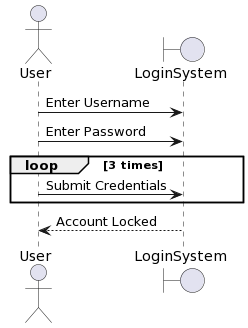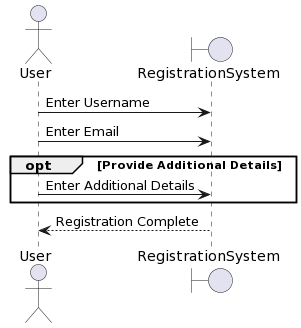Mastering Sequence Diagrams: Unraveling the Power of Fragments – Loop, Alternative, and Option
Introduction:
Sequence diagrams serve as the blueprint of dynamic interactions within software systems, offering a visual narrative of how objects communicate over time. To amplify the communicative power of these diagrams, fragments come into play, providing a nuanced way to depict repetitive actions, alternative paths, and optional interactions. In this exploration, we unravel the essence of three key fragments – Loop, Alternative, and Option – each contributing to the depth and clarity of sequence diagrams.
Fragments – Loop, Alternative, and Option in Sequence Diagram
Sequence diagrams are powerful tools in the realm of software development, offering a visual representation of interactions between objects over time. To enhance the expressiveness and flexibility of these diagrams, fragments come into play. Among the various types of fragments, three stand out: Loop, Alternative, and Option.
In this article, we will delve into the intricacies of these fragments and explore how they elevate the clarity and precision of sequence diagrams.
- Loop Fragment:
The Loop fragment is a dynamic way to represent repetitive actions in a sequence diagram. It helps to model scenarios where a specific set of interactions needs to be repeated multiple times. This fragment is denoted by a rectangle with a small loop icon in the upper-left corner.

Consider a scenario where a user attempts to log in with an incorrect password three times before being locked out. In a sequence diagram, the Loop fragment can succinctly capture this repetition without cluttering the diagram with redundant details.
- Alternative Fragment:
The Alternative fragment is invaluable for representing alternative paths or conditional behaviors within a sequence diagram. It allows the modeler to depict different scenarios based on conditions, enhancing the diagram’s ability to convey complex logic. The Alternative fragment is denoted by a rectangle with a small ‘alt’ keyword.

Imagine a scenario where a user can log in using either a password or a fingerprint. The Alternative fragment can elegantly capture this branching logic.
- Option Fragment:
The Option fragment is used to represent optional interactions within a sequence diagram. It allows modelers to convey that certain interactions may or may not occur based on specific conditions. The Option fragment is denoted by a rectangle with a small ‘opt’ keyword.

Consider a scenario where a user can choose to provide additional details during a registration process. The Option fragment can effectively capture this optional step.
Should You Use Complex Elements in Sequence Diagrams
The decision to employ complex elements like Loop, Alternative, and Option fragments in sequence diagrams hinges on the complexity of the system being modeled and the audience for whom the diagrams are intended. Let’s weigh the pros and cons to determine if their inclusion is beneficial or not.
Pros:
-
Clarity and Precision:
- Complex systems often involve intricate logic and conditional behaviors. Fragments provide a concise and precise way to represent these complexities, making it easier for developers and stakeholders to understand the system’s dynamics.
-
Communication and Documentation:
- Sequence diagrams are not just blueprints for coding; they also serve as communication tools. Fragments enhance the communicative power of sequence diagrams by providing a visual representation of dynamic scenarios. This aids in documentation and facilitates effective communication among team members.
-
Scenario Representation:
- Fragments excel at representing real-world scenarios. For instance, loops can capture repetitive actions such as login attempts, while alternative and option fragments can depict decision points and optional interactions, respectively. This level of detail is often crucial for comprehensive system understanding.
Cons:
-
Simplicity vs. Complexity Trade-off:
- In simpler systems, the inclusion of complex fragments might introduce unnecessary complexity and could potentially confuse readers. It’s essential to strike a balance between providing detailed information and keeping the diagram understandable.
-
Learning Curve:
- Introducing fragments requires users to familiarize themselves with the notation, which might pose a learning curve. In situations where rapid comprehension is crucial, opting for simpler representations might be more efficient.
-
Diagram Maintenance:
- As systems evolve, so do sequence diagrams. Complex elements may require more effort to update and maintain. If the cost of maintaining the diagrams outweighs the benefits of added detail, a simpler representation might be preferable.
The decision to use complex elements in sequence diagrams is context-dependent. For large and intricate systems with complex interactions, fragments can be invaluable in conveying the system’s nuances. However, for smaller, straightforward systems, simplicity might prevail. Striking a balance and considering the audience’s familiarity with the notation are key factors in deciding whether to embrace or abstain from these complex elements. Ultimately, the goal is effective communication and comprehension without unnecessary complication.
Conclusion
In the intricate tapestry of software development, Sequence Diagrams stand as vital artifacts for understanding system behavior. The introduction of Loop, Alternative, and Option fragments elevates these diagrams to a new level of expressiveness. The Loop fragment weaves a story of repetition, the Alternative fragment orchestrates branching narratives, and the Option fragment delicately handles optional interactions. Together, these fragments empower developers and stakeholders alike to comprehend complex scenarios with clarity and precision, making sequence diagrams an indispensable tool in the software development arsenal.
Incorporating Loop, Alternative, and Option fragments into sequence diagrams elevates their expressiveness and enables a more nuanced representation of complex scenarios. These fragments bring clarity to repetitive processes, conditional behaviors, and optional interactions, making sequence diagrams a powerful tool for communication and documentation in software development. As you embark on your journey of creating sequence diagrams, remember that fragments are your allies in crafting diagrams that speak volumes with precision and elegance.

